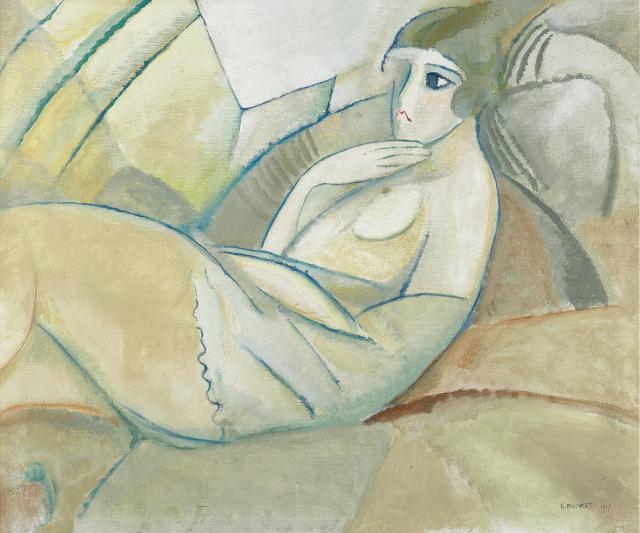The year 1917 corresponds to the period when Gustave Buchet comes around to the stylistic considerations of the Italian Futurists, for whom “the splendour of the world has been enriched by a new beauty: the beauty of speed. A racing car… is more beautiful than the Victory of Samothrace”. (Marinetti, “The Futurist Manifesto”, 1909). But if Buchet shares the Futurists’ interest in movement, his subjects remain poles apart from the themes they exploited. Thus, Femme allongée (Reclining Woman) displays the classic beauty of a female nude, precisely the kind of theme the Italian artists rejected. Yet the layout of his composition, its spasmodic rhythm and deconstruction of the volumes do connect it with the Futurist movement.
Femme allongée is entirely articulated around the lines that structure the naked body and its surroundings, entangling the two and blending them in an indistinct confusion. A variety of viewpoints for one and the same object, a feature of Cubism, is seen in the juxtaposition of the abstract forms making up the setting. The body is also treated in an oversimplified way: the womanly curves are suggested solely by a few twisting lines around the volumes, which are only slightly worked by the artist.
Here Buchet uses a bright, luminous palette that is reduced to a few shades of ochre and light green, all of which is accomplished with a thoroughly light touch. As for the depiction of space in the piece, it is subjected to an absence of perspective and depth. Stylistically Buchet reinterprets Futurism in order to make it his own, and takes advantage of the freedom of expression that that offers to experience a more intuitive conception of space. Tradition (the choice of subject) meets innovation (the style) in this harmonious composition.
Femme allongée is entirely articulated around the lines that structure the naked body and its surroundings, entangling the two and blending them in an indistinct confusion. A variety of viewpoints for one and the same object, a feature of Cubism, is seen in the juxtaposition of the abstract forms making up the setting. The body is also treated in an oversimplified way: the womanly curves are suggested solely by a few twisting lines around the volumes, which are only slightly worked by the artist.
Here Buchet uses a bright, luminous palette that is reduced to a few shades of ochre and light green, all of which is accomplished with a thoroughly light touch. As for the depiction of space in the piece, it is subjected to an absence of perspective and depth. Stylistically Buchet reinterprets Futurism in order to make it his own, and takes advantage of the freedom of expression that that offers to experience a more intuitive conception of space. Tradition (the choice of subject) meets innovation (the style) in this harmonious composition.
